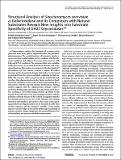Por favor, use este identificador para citar o enlazar a este item:
http://hdl.handle.net/10261/253386COMPARTIR / EXPORTAR:
 SHARE SHARE
 CORE
BASE CORE
BASE
|
|
| Visualizar otros formatos: MARC | Dublin Core | RDF | ORE | MODS | METS | DIDL | DATACITE | |

| Título: | Structural analysis of Saccharomyces cerevisiae α-galactosidase and its complexes with natural substrates reveals new insights into substrate specificity of GH27 glycosidases |
Autor: | Fernández-Leiro, Rafael CSIC ORCID; Pereira-Rodríguez, Ángel; Cerdán, M. Esperanza; Becerra, Manuel; Sanz-Aparicio, J. CSIC ORCID | Fecha de publicación: | 3-sep-2010 | Editor: | American Society for Biochemistry and Molecular Biology | Citación: | Journal of Biological Chemistry 285: 28020-28033 (2010) | Resumen: | α-Galactosidases catalyze the hydrolysis of terminal α-1,6-galactosyl units from galacto-oligosaccharides and polymeric galactomannans. The crystal structures of tetrameric Saccharomyces cerevisiae α-galactosidase and its complexes with the substrates melibiose and raffinose have been determined to 1.95, 2.40, and 2.70 Å resolution. The monomer folds into a catalytic (α/β)8 barrel and a C-terminal β-sandwich domain with unassigned function. This pattern is conserved with other family 27 glycosidases, but this enzyme presents a unique 45-residue insertion in the β-sandwich domain that folds over the barrel protecting it from the solvent and likely explaining its high stability. The structure of the complexes and the mutational analysis show that oligomerization is a key factor in substrate binding, as the substrates are located in a deep cavity making direct interactions with the adjacent subunit. Furthermore, docking analysis suggests that the supplementary domain could be involved in binding sugar units distal from the scissile bond, therefore ascribing a role in fine-tuning substrate specificity to this domain. It may also have a role in promoting association with the polymeric substrate because of the ordered arrangement that the four domains present in one face of the tetramer. Our analysis extends to other family 27 glycosidases, where some traits regarding specificity and oligomerization can be formulated on the basis of their sequence and the structures available. These results improve our knowledge on the activity of this important family of enzymes and give a deeper insight into the structural features that rule modularity and protein-carbohydrate interactions. © 2010 by The American Society for Biochemistry and Molecular Biology, Inc. | Descripción: | 14 pags, 8 figs, 3 tabs. -- Supplementary material is available at the Publisher's web | Versión del editor: | http://dx.doi.org/10.1074/jbc.M110.144584 | URI: | http://hdl.handle.net/10261/253386 | DOI: | 10.1074/jbc.M110.144584 | Identificadores: | doi: 10.1074/jbc.M110.144584 issn: 0021-9258 |
| Aparece en las colecciones: | (IQF) Artículos |
Ficheros en este ítem:
| Fichero | Descripción | Tamaño | Formato | |
|---|---|---|---|---|
| Saccharomyces_cerevisiae_α-Galactosidase.pdf | 5,34 MB | Adobe PDF |  Visualizar/Abrir |
CORE Recommender
Page view(s)
37
checked on 27-abr-2024
Download(s)
44
checked on 27-abr-2024
Google ScholarTM
Check
Altmetric
Altmetric
Este item está licenciado bajo una Licencia Creative Commons

